Organizational Behaviour Report: Waitrose's Culture and Motivation
VerifiedAdded on 2021/02/20
|18
|5655
|49
Report
AI Summary
This report provides a comprehensive analysis of organizational behaviour within the context of Waitrose, a British supermarket chain. It begins by exploring the impact of organizational culture, politics, and power dynamics on team behaviour and performance, referencing Charles Handy's cultural model. The report then evaluates content and process theories of motivation, including Maslow's hierarchy of needs, Alderfer's ERG theory, and Vroom's expectancy theory, to assess how these motivational techniques enable effective goal achievement within an organizational setting. Furthermore, the report demonstrates an understanding of the characteristics that distinguish effective teams from ineffective ones. Finally, it examines key concepts and philosophies of organizational behaviour, offering insights into how these elements contribute to the overall success of the organization. The report highlights the importance of understanding employee behaviour, motivation, and organizational structure to achieve desired outcomes, and it uses Waitrose as a case study to illustrate these concepts.
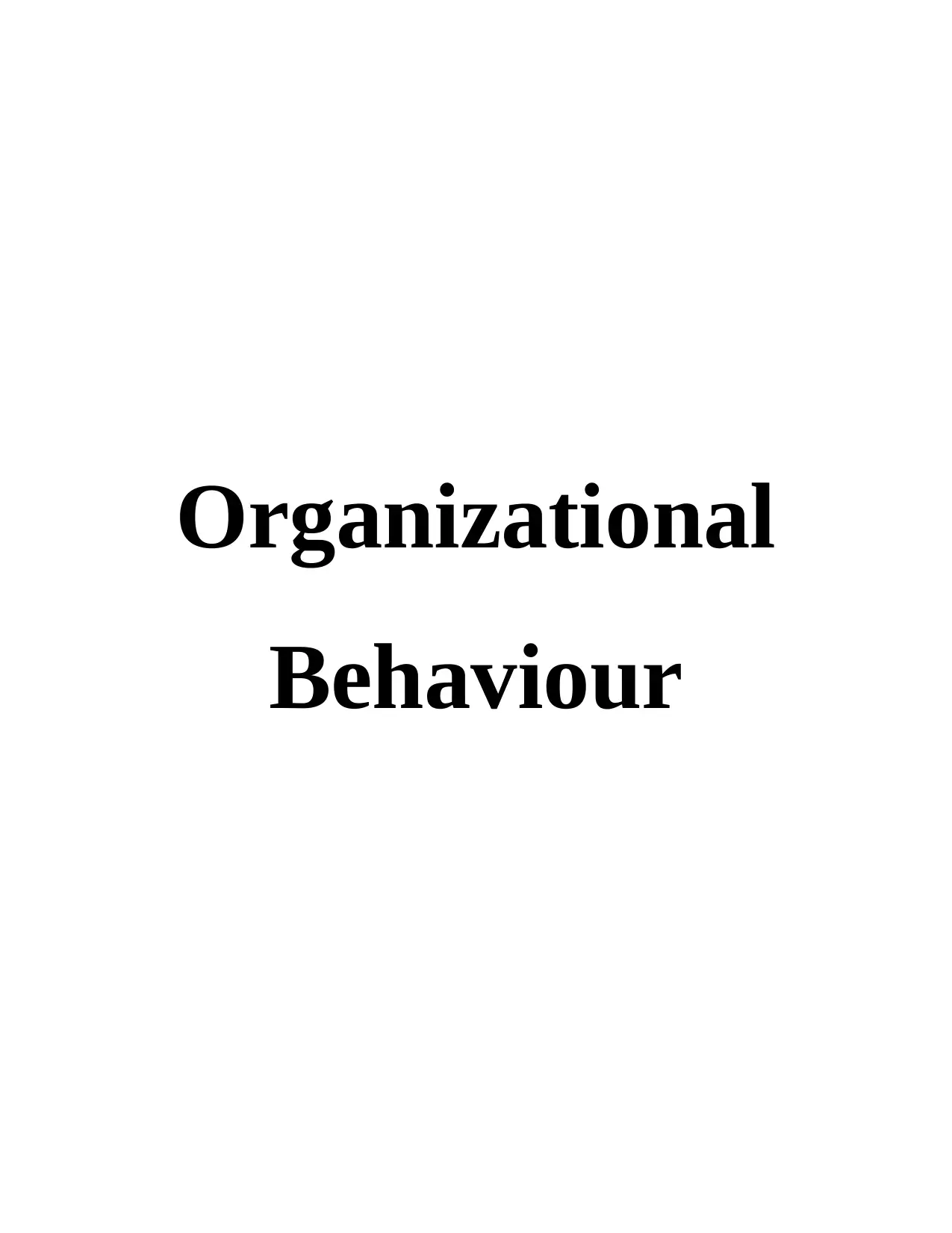
Organizational
Behaviour
Behaviour
Paraphrase This Document
Need a fresh take? Get an instant paraphrase of this document with our AI Paraphraser
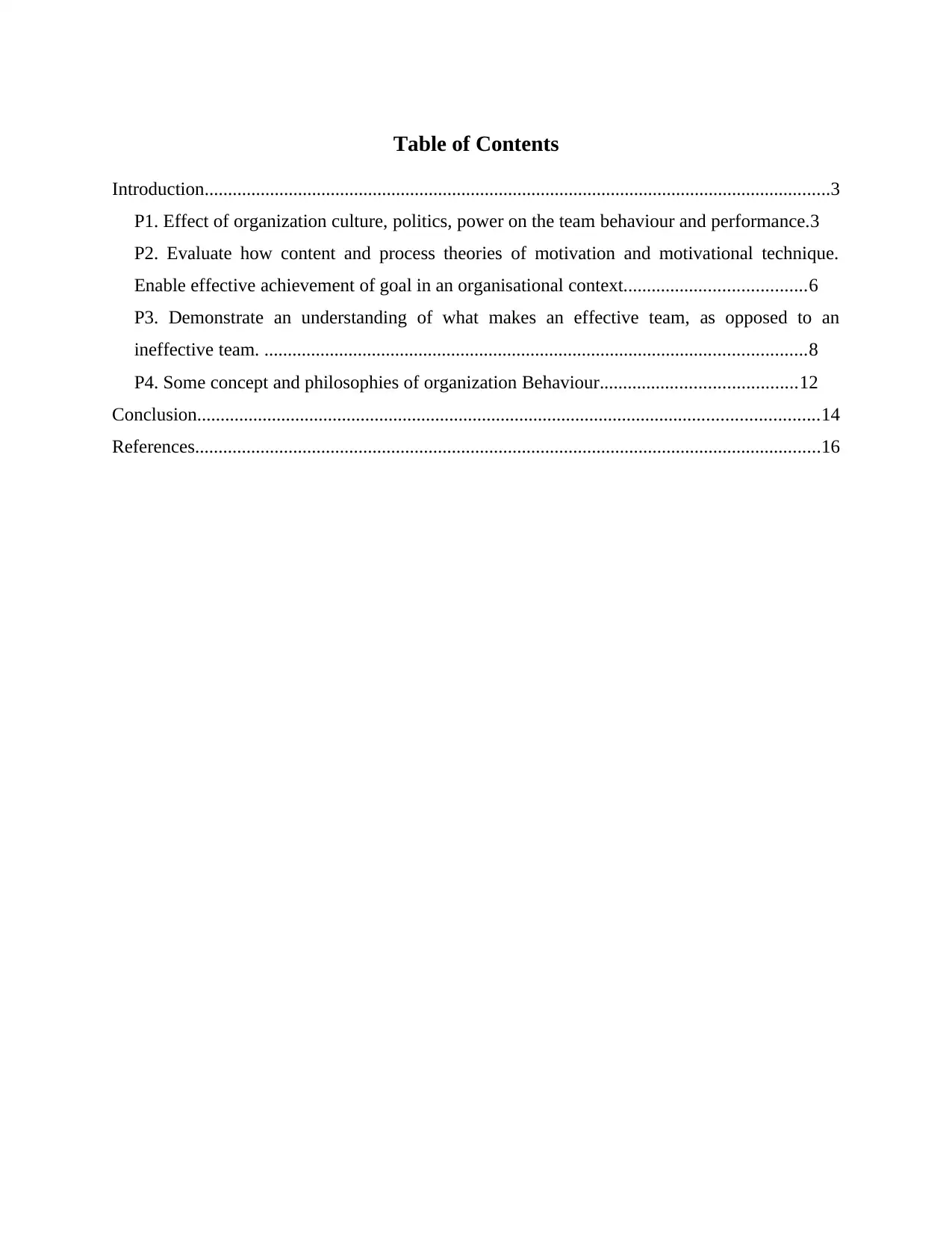
Table of Contents
Introduction......................................................................................................................................3
P1. Effect of organization culture, politics, power on the team behaviour and performance.3
P2. Evaluate how content and process theories of motivation and motivational technique.
Enable effective achievement of goal in an organisational context.......................................6
P3. Demonstrate an understanding of what makes an effective team, as opposed to an
ineffective team. ....................................................................................................................8
P4. Some concept and philosophies of organization Behaviour..........................................12
Conclusion.....................................................................................................................................14
References......................................................................................................................................16
Introduction......................................................................................................................................3
P1. Effect of organization culture, politics, power on the team behaviour and performance.3
P2. Evaluate how content and process theories of motivation and motivational technique.
Enable effective achievement of goal in an organisational context.......................................6
P3. Demonstrate an understanding of what makes an effective team, as opposed to an
ineffective team. ....................................................................................................................8
P4. Some concept and philosophies of organization Behaviour..........................................12
Conclusion.....................................................................................................................................14
References......................................................................................................................................16
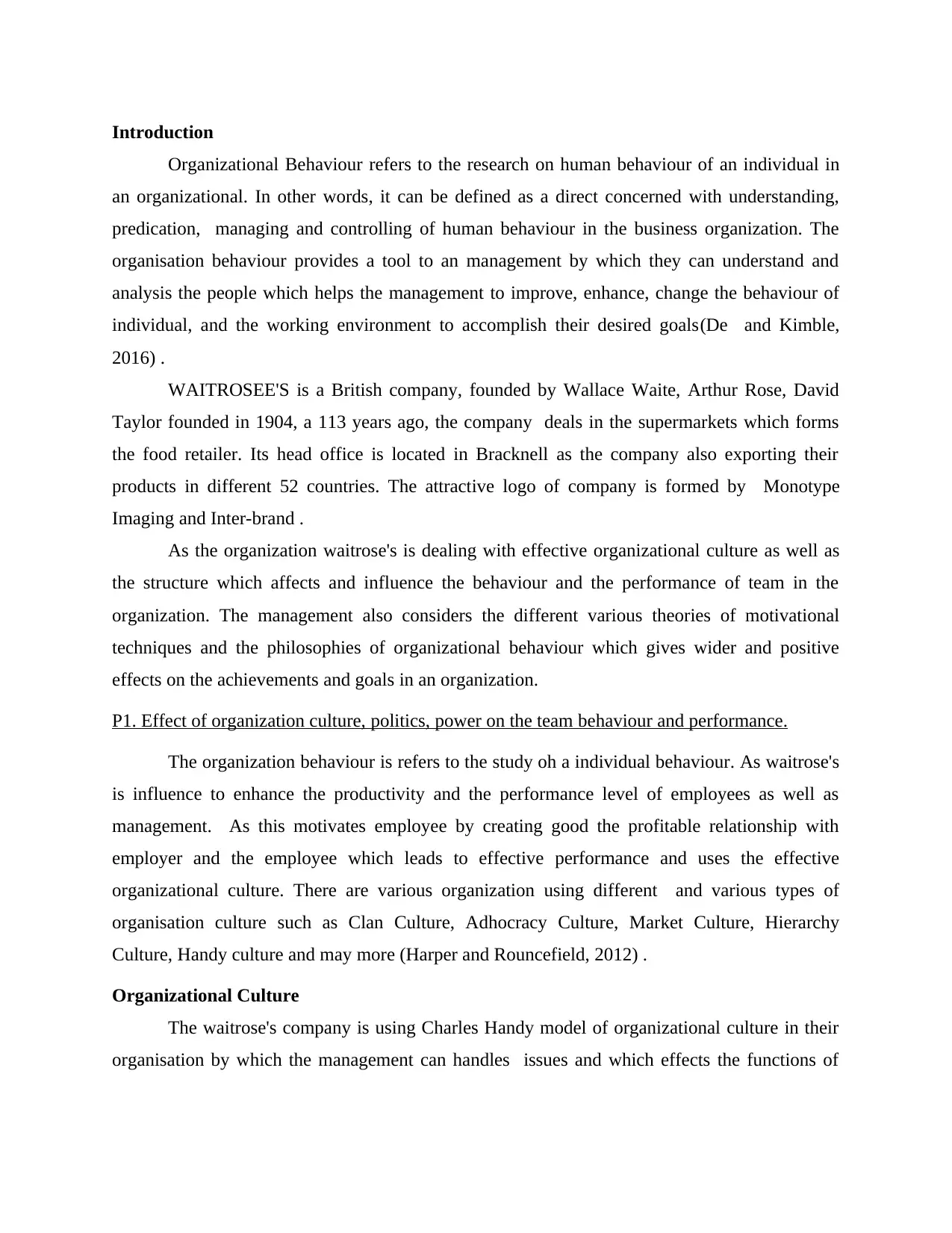
Introduction
Organizational Behaviour refers to the research on human behaviour of an individual in
an organizational. In other words, it can be defined as a direct concerned with understanding,
predication, managing and controlling of human behaviour in the business organization. The
organisation behaviour provides a tool to an management by which they can understand and
analysis the people which helps the management to improve, enhance, change the behaviour of
individual, and the working environment to accomplish their desired goals(De and Kimble,
2016) .
WAITROSEE'S is a British company, founded by Wallace Waite, Arthur Rose, David
Taylor founded in 1904, a 113 years ago, the company deals in the supermarkets which forms
the food retailer. Its head office is located in Bracknell as the company also exporting their
products in different 52 countries. The attractive logo of company is formed by Monotype
Imaging and Inter-brand .
As the organization waitrose's is dealing with effective organizational culture as well as
the structure which affects and influence the behaviour and the performance of team in the
organization. The management also considers the different various theories of motivational
techniques and the philosophies of organizational behaviour which gives wider and positive
effects on the achievements and goals in an organization.
P1. Effect of organization culture, politics, power on the team behaviour and performance.
The organization behaviour is refers to the study oh a individual behaviour. As waitrose's
is influence to enhance the productivity and the performance level of employees as well as
management. As this motivates employee by creating good the profitable relationship with
employer and the employee which leads to effective performance and uses the effective
organizational culture. There are various organization using different and various types of
organisation culture such as Clan Culture, Adhocracy Culture, Market Culture, Hierarchy
Culture, Handy culture and may more (Harper and Rouncefield, 2012) .
Organizational Culture
The waitrose's company is using Charles Handy model of organizational culture in their
organisation by which the management can handles issues and which effects the functions of
Organizational Behaviour refers to the research on human behaviour of an individual in
an organizational. In other words, it can be defined as a direct concerned with understanding,
predication, managing and controlling of human behaviour in the business organization. The
organisation behaviour provides a tool to an management by which they can understand and
analysis the people which helps the management to improve, enhance, change the behaviour of
individual, and the working environment to accomplish their desired goals(De and Kimble,
2016) .
WAITROSEE'S is a British company, founded by Wallace Waite, Arthur Rose, David
Taylor founded in 1904, a 113 years ago, the company deals in the supermarkets which forms
the food retailer. Its head office is located in Bracknell as the company also exporting their
products in different 52 countries. The attractive logo of company is formed by Monotype
Imaging and Inter-brand .
As the organization waitrose's is dealing with effective organizational culture as well as
the structure which affects and influence the behaviour and the performance of team in the
organization. The management also considers the different various theories of motivational
techniques and the philosophies of organizational behaviour which gives wider and positive
effects on the achievements and goals in an organization.
P1. Effect of organization culture, politics, power on the team behaviour and performance.
The organization behaviour is refers to the study oh a individual behaviour. As waitrose's
is influence to enhance the productivity and the performance level of employees as well as
management. As this motivates employee by creating good the profitable relationship with
employer and the employee which leads to effective performance and uses the effective
organizational culture. There are various organization using different and various types of
organisation culture such as Clan Culture, Adhocracy Culture, Market Culture, Hierarchy
Culture, Handy culture and may more (Harper and Rouncefield, 2012) .
Organizational Culture
The waitrose's company is using Charles Handy model of organizational culture in their
organisation by which the management can handles issues and which effects the functions of
⊘ This is a preview!⊘
Do you want full access?
Subscribe today to unlock all pages.

Trusted by 1+ million students worldwide
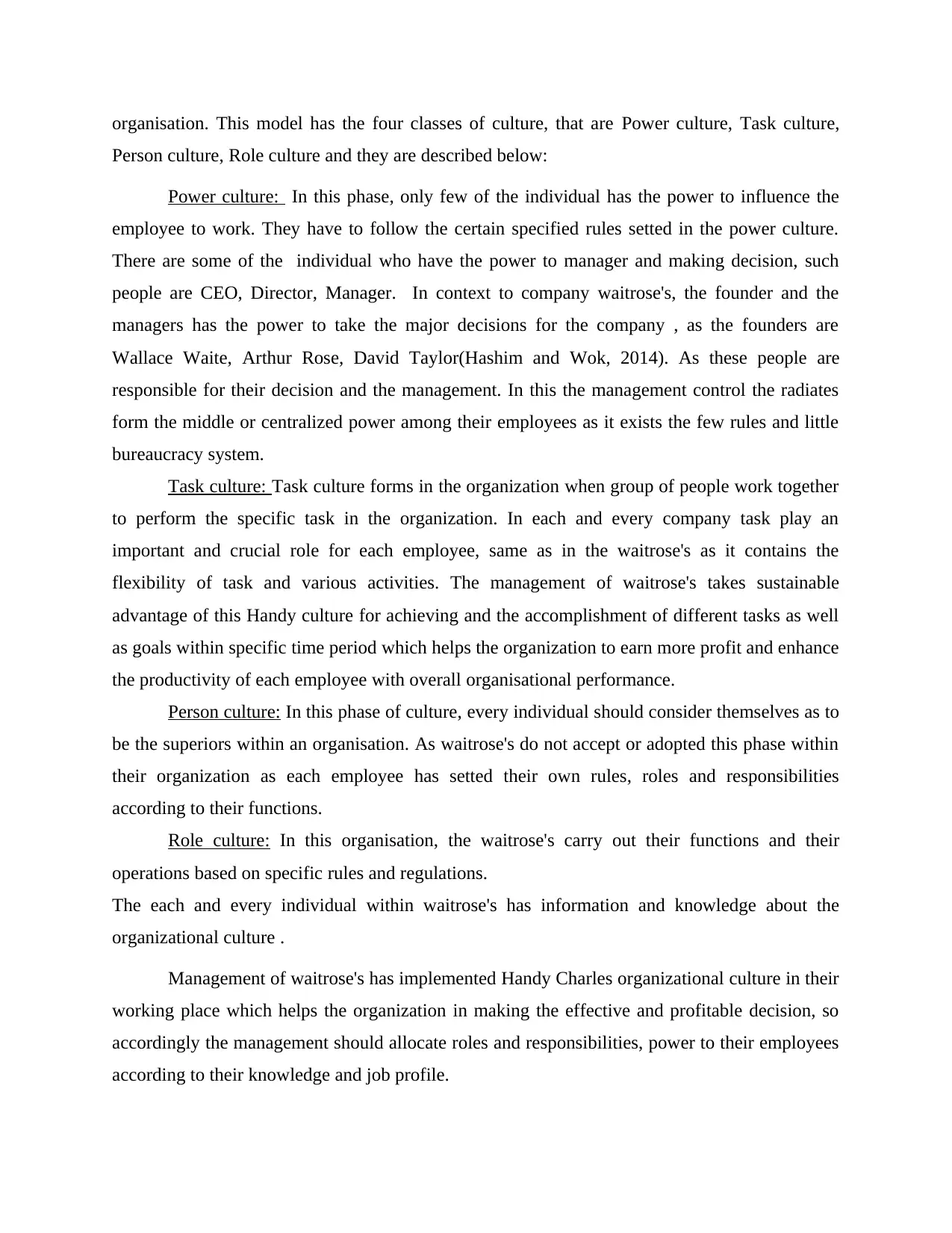
organisation. This model has the four classes of culture, that are Power culture, Task culture,
Person culture, Role culture and they are described below:
Power culture: In this phase, only few of the individual has the power to influence the
employee to work. They have to follow the certain specified rules setted in the power culture.
There are some of the individual who have the power to manager and making decision, such
people are CEO, Director, Manager. In context to company waitrose's, the founder and the
managers has the power to take the major decisions for the company , as the founders are
Wallace Waite, Arthur Rose, David Taylor(Hashim and Wok, 2014). As these people are
responsible for their decision and the management. In this the management control the radiates
form the middle or centralized power among their employees as it exists the few rules and little
bureaucracy system.
Task culture: Task culture forms in the organization when group of people work together
to perform the specific task in the organization. In each and every company task play an
important and crucial role for each employee, same as in the waitrose's as it contains the
flexibility of task and various activities. The management of waitrose's takes sustainable
advantage of this Handy culture for achieving and the accomplishment of different tasks as well
as goals within specific time period which helps the organization to earn more profit and enhance
the productivity of each employee with overall organisational performance.
Person culture: In this phase of culture, every individual should consider themselves as to
be the superiors within an organisation. As waitrose's do not accept or adopted this phase within
their organization as each employee has setted their own rules, roles and responsibilities
according to their functions.
Role culture: In this organisation, the waitrose's carry out their functions and their
operations based on specific rules and regulations.
The each and every individual within waitrose's has information and knowledge about the
organizational culture .
Management of waitrose's has implemented Handy Charles organizational culture in their
working place which helps the organization in making the effective and profitable decision, so
accordingly the management should allocate roles and responsibilities, power to their employees
according to their knowledge and job profile.
Person culture, Role culture and they are described below:
Power culture: In this phase, only few of the individual has the power to influence the
employee to work. They have to follow the certain specified rules setted in the power culture.
There are some of the individual who have the power to manager and making decision, such
people are CEO, Director, Manager. In context to company waitrose's, the founder and the
managers has the power to take the major decisions for the company , as the founders are
Wallace Waite, Arthur Rose, David Taylor(Hashim and Wok, 2014). As these people are
responsible for their decision and the management. In this the management control the radiates
form the middle or centralized power among their employees as it exists the few rules and little
bureaucracy system.
Task culture: Task culture forms in the organization when group of people work together
to perform the specific task in the organization. In each and every company task play an
important and crucial role for each employee, same as in the waitrose's as it contains the
flexibility of task and various activities. The management of waitrose's takes sustainable
advantage of this Handy culture for achieving and the accomplishment of different tasks as well
as goals within specific time period which helps the organization to earn more profit and enhance
the productivity of each employee with overall organisational performance.
Person culture: In this phase of culture, every individual should consider themselves as to
be the superiors within an organisation. As waitrose's do not accept or adopted this phase within
their organization as each employee has setted their own rules, roles and responsibilities
according to their functions.
Role culture: In this organisation, the waitrose's carry out their functions and their
operations based on specific rules and regulations.
The each and every individual within waitrose's has information and knowledge about the
organizational culture .
Management of waitrose's has implemented Handy Charles organizational culture in their
working place which helps the organization in making the effective and profitable decision, so
accordingly the management should allocate roles and responsibilities, power to their employees
according to their knowledge and job profile.
Paraphrase This Document
Need a fresh take? Get an instant paraphrase of this document with our AI Paraphraser
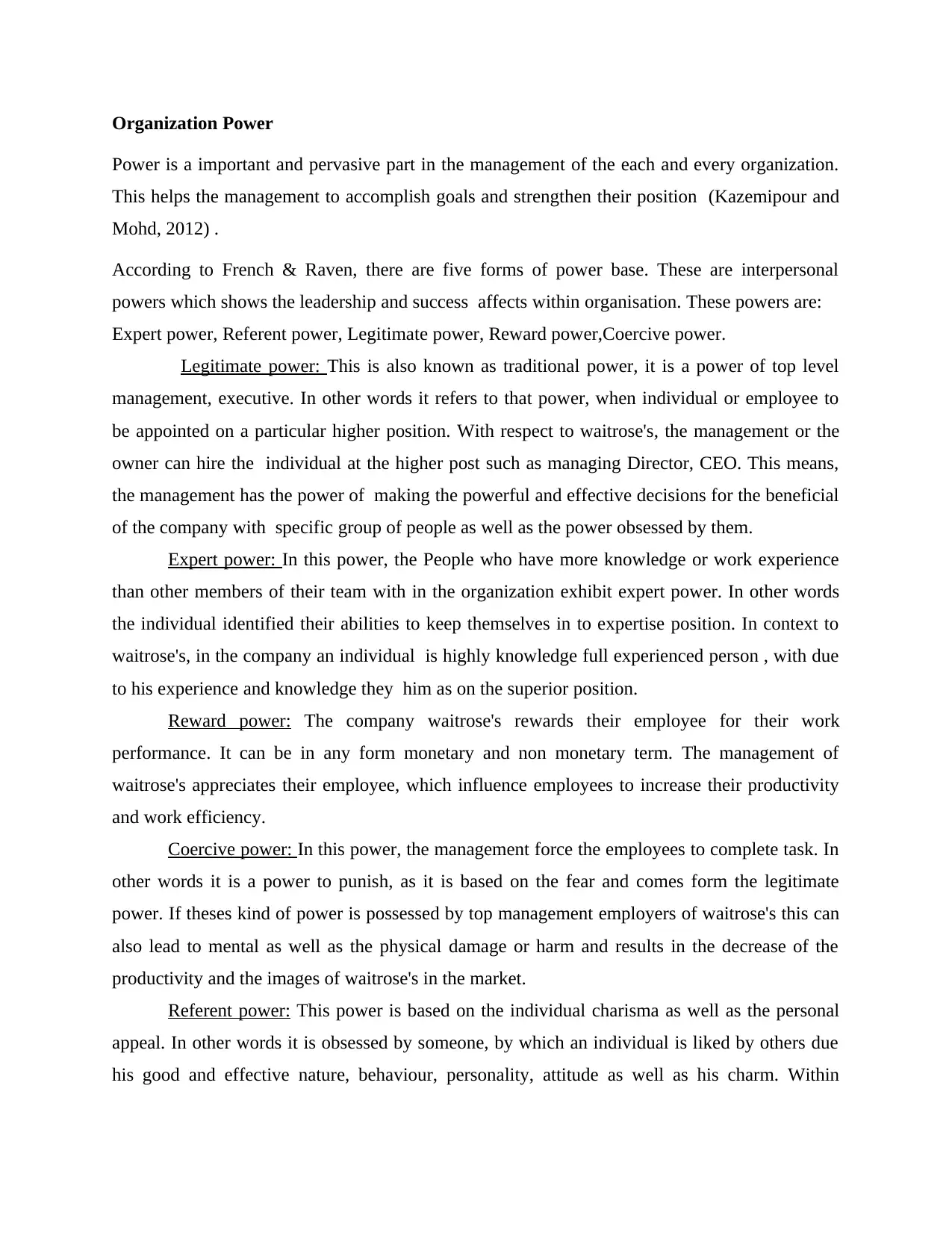
Organization Power
Power is a important and pervasive part in the management of the each and every organization.
This helps the management to accomplish goals and strengthen their position (Kazemipour and
Mohd, 2012) .
According to French & Raven, there are five forms of power base. These are interpersonal
powers which shows the leadership and success affects within organisation. These powers are:
Expert power, Referent power, Legitimate power, Reward power,Coercive power.
Legitimate power: This is also known as traditional power, it is a power of top level
management, executive. In other words it refers to that power, when individual or employee to
be appointed on a particular higher position. With respect to waitrose's, the management or the
owner can hire the individual at the higher post such as managing Director, CEO. This means,
the management has the power of making the powerful and effective decisions for the beneficial
of the company with specific group of people as well as the power obsessed by them.
Expert power: In this power, the People who have more knowledge or work experience
than other members of their team with in the organization exhibit expert power. In other words
the individual identified their abilities to keep themselves in to expertise position. In context to
waitrose's, in the company an individual is highly knowledge full experienced person , with due
to his experience and knowledge they him as on the superior position.
Reward power: The company waitrose's rewards their employee for their work
performance. It can be in any form monetary and non monetary term. The management of
waitrose's appreciates their employee, which influence employees to increase their productivity
and work efficiency.
Coercive power: In this power, the management force the employees to complete task. In
other words it is a power to punish, as it is based on the fear and comes form the legitimate
power. If theses kind of power is possessed by top management employers of waitrose's this can
also lead to mental as well as the physical damage or harm and results in the decrease of the
productivity and the images of waitrose's in the market.
Referent power: This power is based on the individual charisma as well as the personal
appeal. In other words it is obsessed by someone, by which an individual is liked by others due
his good and effective nature, behaviour, personality, attitude as well as his charm. Within
Power is a important and pervasive part in the management of the each and every organization.
This helps the management to accomplish goals and strengthen their position (Kazemipour and
Mohd, 2012) .
According to French & Raven, there are five forms of power base. These are interpersonal
powers which shows the leadership and success affects within organisation. These powers are:
Expert power, Referent power, Legitimate power, Reward power,Coercive power.
Legitimate power: This is also known as traditional power, it is a power of top level
management, executive. In other words it refers to that power, when individual or employee to
be appointed on a particular higher position. With respect to waitrose's, the management or the
owner can hire the individual at the higher post such as managing Director, CEO. This means,
the management has the power of making the powerful and effective decisions for the beneficial
of the company with specific group of people as well as the power obsessed by them.
Expert power: In this power, the People who have more knowledge or work experience
than other members of their team with in the organization exhibit expert power. In other words
the individual identified their abilities to keep themselves in to expertise position. In context to
waitrose's, in the company an individual is highly knowledge full experienced person , with due
to his experience and knowledge they him as on the superior position.
Reward power: The company waitrose's rewards their employee for their work
performance. It can be in any form monetary and non monetary term. The management of
waitrose's appreciates their employee, which influence employees to increase their productivity
and work efficiency.
Coercive power: In this power, the management force the employees to complete task. In
other words it is a power to punish, as it is based on the fear and comes form the legitimate
power. If theses kind of power is possessed by top management employers of waitrose's this can
also lead to mental as well as the physical damage or harm and results in the decrease of the
productivity and the images of waitrose's in the market.
Referent power: This power is based on the individual charisma as well as the personal
appeal. In other words it is obsessed by someone, by which an individual is liked by others due
his good and effective nature, behaviour, personality, attitude as well as his charm. Within
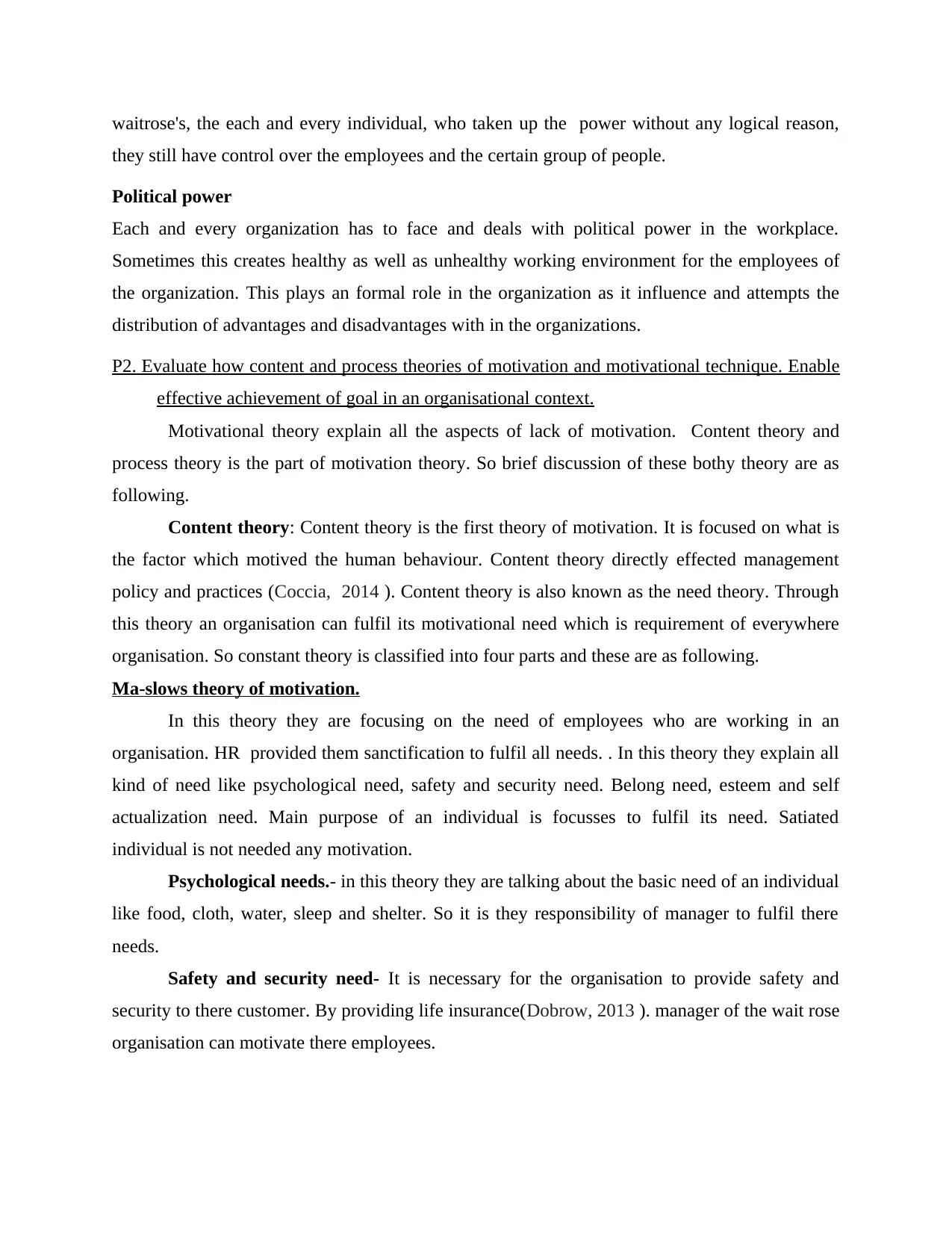
waitrose's, the each and every individual, who taken up the power without any logical reason,
they still have control over the employees and the certain group of people.
Political power
Each and every organization has to face and deals with political power in the workplace.
Sometimes this creates healthy as well as unhealthy working environment for the employees of
the organization. This plays an formal role in the organization as it influence and attempts the
distribution of advantages and disadvantages with in the organizations.
P2. Evaluate how content and process theories of motivation and motivational technique. Enable
effective achievement of goal in an organisational context.
Motivational theory explain all the aspects of lack of motivation. Content theory and
process theory is the part of motivation theory. So brief discussion of these bothy theory are as
following.
Content theory: Content theory is the first theory of motivation. It is focused on what is
the factor which motived the human behaviour. Content theory directly effected management
policy and practices (Coccia, 2014 ). Content theory is also known as the need theory. Through
this theory an organisation can fulfil its motivational need which is requirement of everywhere
organisation. So constant theory is classified into four parts and these are as following.
Ma-slows theory of motivation.
In this theory they are focusing on the need of employees who are working in an
organisation. HR provided them sanctification to fulfil all needs. . In this theory they explain all
kind of need like psychological need, safety and security need. Belong need, esteem and self
actualization need. Main purpose of an individual is focusses to fulfil its need. Satiated
individual is not needed any motivation.
Psychological needs.- in this theory they are talking about the basic need of an individual
like food, cloth, water, sleep and shelter. So it is they responsibility of manager to fulfil there
needs.
Safety and security need- It is necessary for the organisation to provide safety and
security to there customer. By providing life insurance(Dobrow, 2013 ). manager of the wait rose
organisation can motivate there employees.
they still have control over the employees and the certain group of people.
Political power
Each and every organization has to face and deals with political power in the workplace.
Sometimes this creates healthy as well as unhealthy working environment for the employees of
the organization. This plays an formal role in the organization as it influence and attempts the
distribution of advantages and disadvantages with in the organizations.
P2. Evaluate how content and process theories of motivation and motivational technique. Enable
effective achievement of goal in an organisational context.
Motivational theory explain all the aspects of lack of motivation. Content theory and
process theory is the part of motivation theory. So brief discussion of these bothy theory are as
following.
Content theory: Content theory is the first theory of motivation. It is focused on what is
the factor which motived the human behaviour. Content theory directly effected management
policy and practices (Coccia, 2014 ). Content theory is also known as the need theory. Through
this theory an organisation can fulfil its motivational need which is requirement of everywhere
organisation. So constant theory is classified into four parts and these are as following.
Ma-slows theory of motivation.
In this theory they are focusing on the need of employees who are working in an
organisation. HR provided them sanctification to fulfil all needs. . In this theory they explain all
kind of need like psychological need, safety and security need. Belong need, esteem and self
actualization need. Main purpose of an individual is focusses to fulfil its need. Satiated
individual is not needed any motivation.
Psychological needs.- in this theory they are talking about the basic need of an individual
like food, cloth, water, sleep and shelter. So it is they responsibility of manager to fulfil there
needs.
Safety and security need- It is necessary for the organisation to provide safety and
security to there customer. By providing life insurance(Dobrow, 2013 ). manager of the wait rose
organisation can motivate there employees.
⊘ This is a preview!⊘
Do you want full access?
Subscribe today to unlock all pages.

Trusted by 1+ million students worldwide
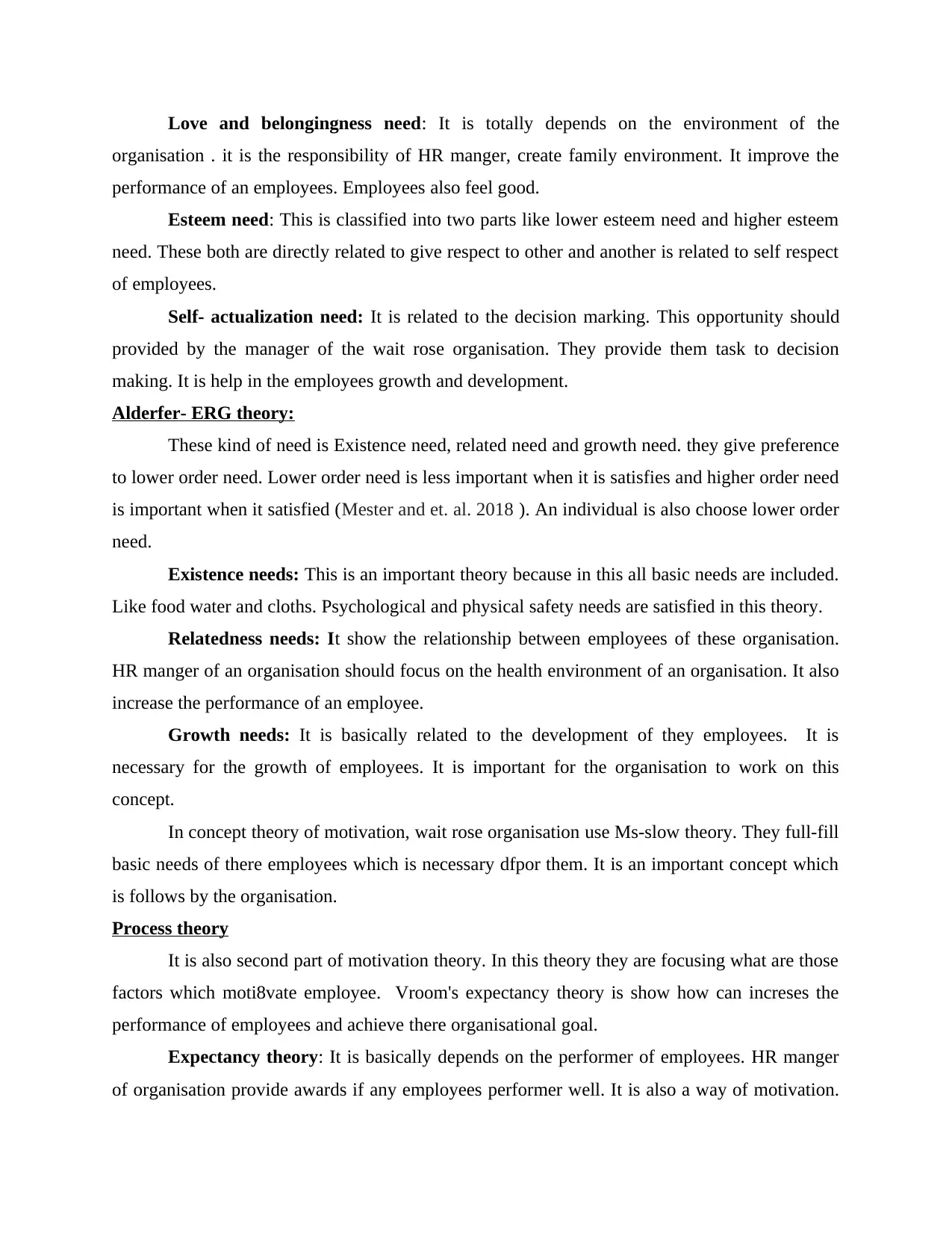
Love and belongingness need: It is totally depends on the environment of the
organisation . it is the responsibility of HR manger, create family environment. It improve the
performance of an employees. Employees also feel good.
Esteem need: This is classified into two parts like lower esteem need and higher esteem
need. These both are directly related to give respect to other and another is related to self respect
of employees.
Self- actualization need: It is related to the decision marking. This opportunity should
provided by the manager of the wait rose organisation. They provide them task to decision
making. It is help in the employees growth and development.
Alderfer- ERG theory:
These kind of need is Existence need, related need and growth need. they give preference
to lower order need. Lower order need is less important when it is satisfies and higher order need
is important when it satisfied (Mester and et. al. 2018 ). An individual is also choose lower order
need.
Existence needs: This is an important theory because in this all basic needs are included.
Like food water and cloths. Psychological and physical safety needs are satisfied in this theory.
Relatedness needs: It show the relationship between employees of these organisation.
HR manger of an organisation should focus on the health environment of an organisation. It also
increase the performance of an employee.
Growth needs: It is basically related to the development of they employees. It is
necessary for the growth of employees. It is important for the organisation to work on this
concept.
In concept theory of motivation, wait rose organisation use Ms-slow theory. They full-fill
basic needs of there employees which is necessary dfpor them. It is an important concept which
is follows by the organisation.
Process theory
It is also second part of motivation theory. In this theory they are focusing what are those
factors which moti8vate employee. Vroom's expectancy theory is show how can increses the
performance of employees and achieve there organisational goal.
Expectancy theory: It is basically depends on the performer of employees. HR manger
of organisation provide awards if any employees performer well. It is also a way of motivation.
organisation . it is the responsibility of HR manger, create family environment. It improve the
performance of an employees. Employees also feel good.
Esteem need: This is classified into two parts like lower esteem need and higher esteem
need. These both are directly related to give respect to other and another is related to self respect
of employees.
Self- actualization need: It is related to the decision marking. This opportunity should
provided by the manager of the wait rose organisation. They provide them task to decision
making. It is help in the employees growth and development.
Alderfer- ERG theory:
These kind of need is Existence need, related need and growth need. they give preference
to lower order need. Lower order need is less important when it is satisfies and higher order need
is important when it satisfied (Mester and et. al. 2018 ). An individual is also choose lower order
need.
Existence needs: This is an important theory because in this all basic needs are included.
Like food water and cloths. Psychological and physical safety needs are satisfied in this theory.
Relatedness needs: It show the relationship between employees of these organisation.
HR manger of an organisation should focus on the health environment of an organisation. It also
increase the performance of an employee.
Growth needs: It is basically related to the development of they employees. It is
necessary for the growth of employees. It is important for the organisation to work on this
concept.
In concept theory of motivation, wait rose organisation use Ms-slow theory. They full-fill
basic needs of there employees which is necessary dfpor them. It is an important concept which
is follows by the organisation.
Process theory
It is also second part of motivation theory. In this theory they are focusing what are those
factors which moti8vate employee. Vroom's expectancy theory is show how can increses the
performance of employees and achieve there organisational goal.
Expectancy theory: It is basically depends on the performer of employees. HR manger
of organisation provide awards if any employees performer well. It is also a way of motivation.
Paraphrase This Document
Need a fresh take? Get an instant paraphrase of this document with our AI Paraphraser
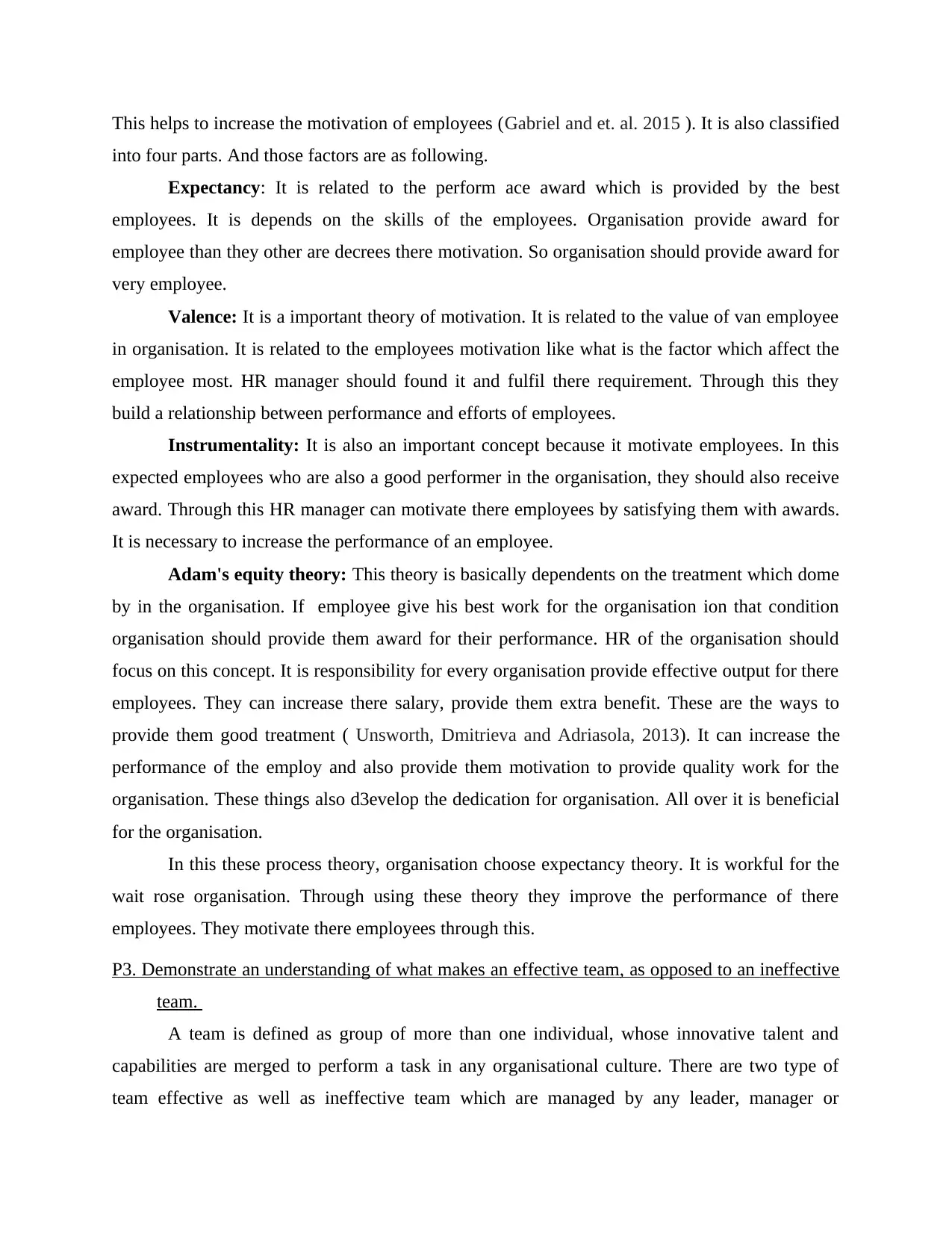
This helps to increase the motivation of employees (Gabriel and et. al. 2015 ). It is also classified
into four parts. And those factors are as following.
Expectancy: It is related to the perform ace award which is provided by the best
employees. It is depends on the skills of the employees. Organisation provide award for
employee than they other are decrees there motivation. So organisation should provide award for
very employee.
Valence: It is a important theory of motivation. It is related to the value of van employee
in organisation. It is related to the employees motivation like what is the factor which affect the
employee most. HR manager should found it and fulfil there requirement. Through this they
build a relationship between performance and efforts of employees.
Instrumentality: It is also an important concept because it motivate employees. In this
expected employees who are also a good performer in the organisation, they should also receive
award. Through this HR manager can motivate there employees by satisfying them with awards.
It is necessary to increase the performance of an employee.
Adam's equity theory: This theory is basically dependents on the treatment which dome
by in the organisation. If employee give his best work for the organisation ion that condition
organisation should provide them award for their performance. HR of the organisation should
focus on this concept. It is responsibility for every organisation provide effective output for there
employees. They can increase there salary, provide them extra benefit. These are the ways to
provide them good treatment ( Unsworth, Dmitrieva and Adriasola, 2013). It can increase the
performance of the employ and also provide them motivation to provide quality work for the
organisation. These things also d3evelop the dedication for organisation. All over it is beneficial
for the organisation.
In this these process theory, organisation choose expectancy theory. It is workful for the
wait rose organisation. Through using these theory they improve the performance of there
employees. They motivate there employees through this.
P3. Demonstrate an understanding of what makes an effective team, as opposed to an ineffective
team.
A team is defined as group of more than one individual, whose innovative talent and
capabilities are merged to perform a task in any organisational culture. There are two type of
team effective as well as ineffective team which are managed by any leader, manager or
into four parts. And those factors are as following.
Expectancy: It is related to the perform ace award which is provided by the best
employees. It is depends on the skills of the employees. Organisation provide award for
employee than they other are decrees there motivation. So organisation should provide award for
very employee.
Valence: It is a important theory of motivation. It is related to the value of van employee
in organisation. It is related to the employees motivation like what is the factor which affect the
employee most. HR manager should found it and fulfil there requirement. Through this they
build a relationship between performance and efforts of employees.
Instrumentality: It is also an important concept because it motivate employees. In this
expected employees who are also a good performer in the organisation, they should also receive
award. Through this HR manager can motivate there employees by satisfying them with awards.
It is necessary to increase the performance of an employee.
Adam's equity theory: This theory is basically dependents on the treatment which dome
by in the organisation. If employee give his best work for the organisation ion that condition
organisation should provide them award for their performance. HR of the organisation should
focus on this concept. It is responsibility for every organisation provide effective output for there
employees. They can increase there salary, provide them extra benefit. These are the ways to
provide them good treatment ( Unsworth, Dmitrieva and Adriasola, 2013). It can increase the
performance of the employ and also provide them motivation to provide quality work for the
organisation. These things also d3evelop the dedication for organisation. All over it is beneficial
for the organisation.
In this these process theory, organisation choose expectancy theory. It is workful for the
wait rose organisation. Through using these theory they improve the performance of there
employees. They motivate there employees through this.
P3. Demonstrate an understanding of what makes an effective team, as opposed to an ineffective
team.
A team is defined as group of more than one individual, whose innovative talent and
capabilities are merged to perform a task in any organisational culture. There are two type of
team effective as well as ineffective team which are managed by any leader, manager or
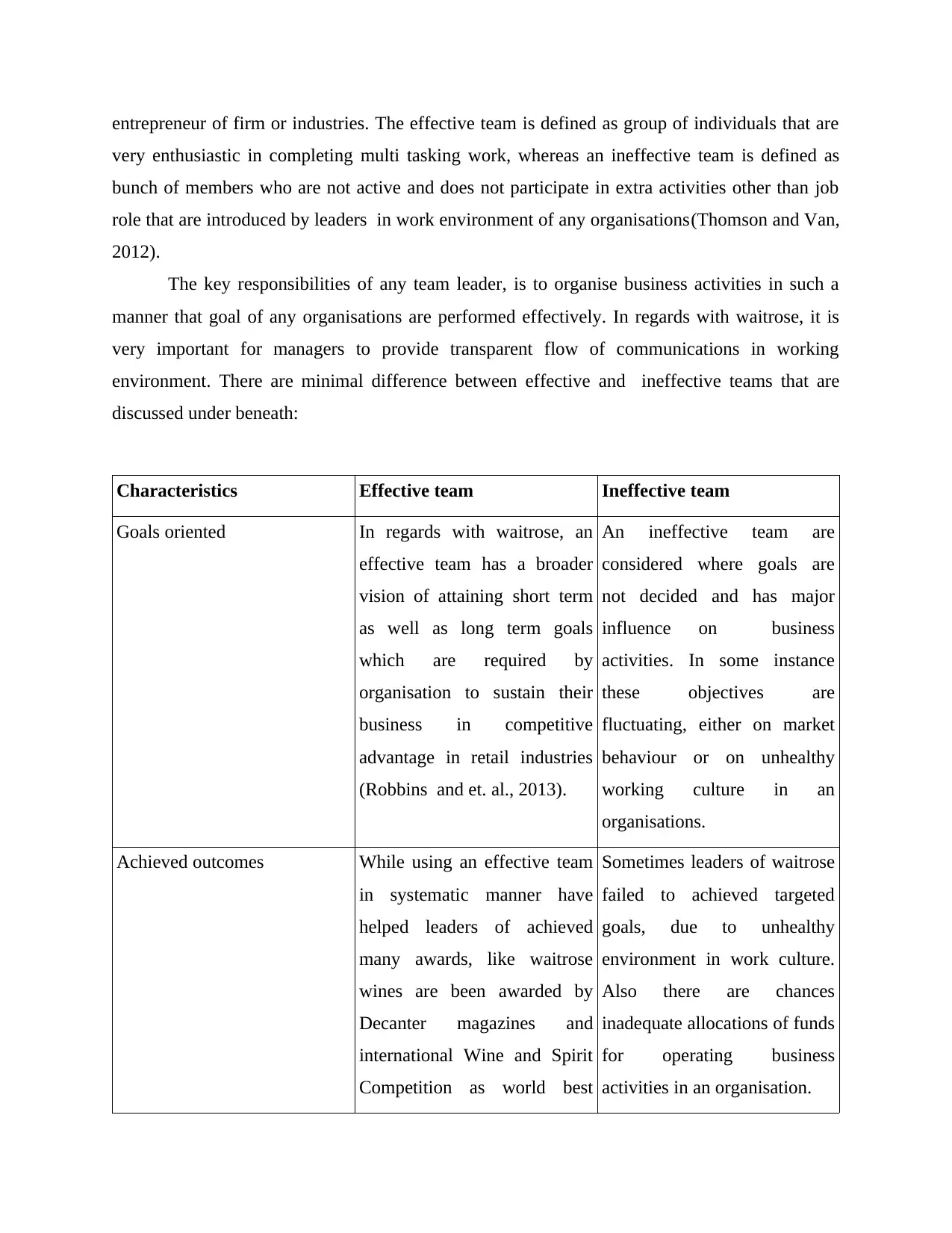
entrepreneur of firm or industries. The effective team is defined as group of individuals that are
very enthusiastic in completing multi tasking work, whereas an ineffective team is defined as
bunch of members who are not active and does not participate in extra activities other than job
role that are introduced by leaders in work environment of any organisations(Thomson and Van,
2012).
The key responsibilities of any team leader, is to organise business activities in such a
manner that goal of any organisations are performed effectively. In regards with waitrose, it is
very important for managers to provide transparent flow of communications in working
environment. There are minimal difference between effective and ineffective teams that are
discussed under beneath:
Characteristics Effective team Ineffective team
Goals oriented In regards with waitrose, an
effective team has a broader
vision of attaining short term
as well as long term goals
which are required by
organisation to sustain their
business in competitive
advantage in retail industries
(Robbins and et. al., 2013).
An ineffective team are
considered where goals are
not decided and has major
influence on business
activities. In some instance
these objectives are
fluctuating, either on market
behaviour or on unhealthy
working culture in an
organisations.
Achieved outcomes While using an effective team
in systematic manner have
helped leaders of achieved
many awards, like waitrose
wines are been awarded by
Decanter magazines and
international Wine and Spirit
Competition as world best
Sometimes leaders of waitrose
failed to achieved targeted
goals, due to unhealthy
environment in work culture.
Also there are chances
inadequate allocations of funds
for operating business
activities in an organisation.
very enthusiastic in completing multi tasking work, whereas an ineffective team is defined as
bunch of members who are not active and does not participate in extra activities other than job
role that are introduced by leaders in work environment of any organisations(Thomson and Van,
2012).
The key responsibilities of any team leader, is to organise business activities in such a
manner that goal of any organisations are performed effectively. In regards with waitrose, it is
very important for managers to provide transparent flow of communications in working
environment. There are minimal difference between effective and ineffective teams that are
discussed under beneath:
Characteristics Effective team Ineffective team
Goals oriented In regards with waitrose, an
effective team has a broader
vision of attaining short term
as well as long term goals
which are required by
organisation to sustain their
business in competitive
advantage in retail industries
(Robbins and et. al., 2013).
An ineffective team are
considered where goals are
not decided and has major
influence on business
activities. In some instance
these objectives are
fluctuating, either on market
behaviour or on unhealthy
working culture in an
organisations.
Achieved outcomes While using an effective team
in systematic manner have
helped leaders of achieved
many awards, like waitrose
wines are been awarded by
Decanter magazines and
international Wine and Spirit
Competition as world best
Sometimes leaders of waitrose
failed to achieved targeted
goals, due to unhealthy
environment in work culture.
Also there are chances
inadequate allocations of funds
for operating business
activities in an organisation.
⊘ This is a preview!⊘
Do you want full access?
Subscribe today to unlock all pages.

Trusted by 1+ million students worldwide
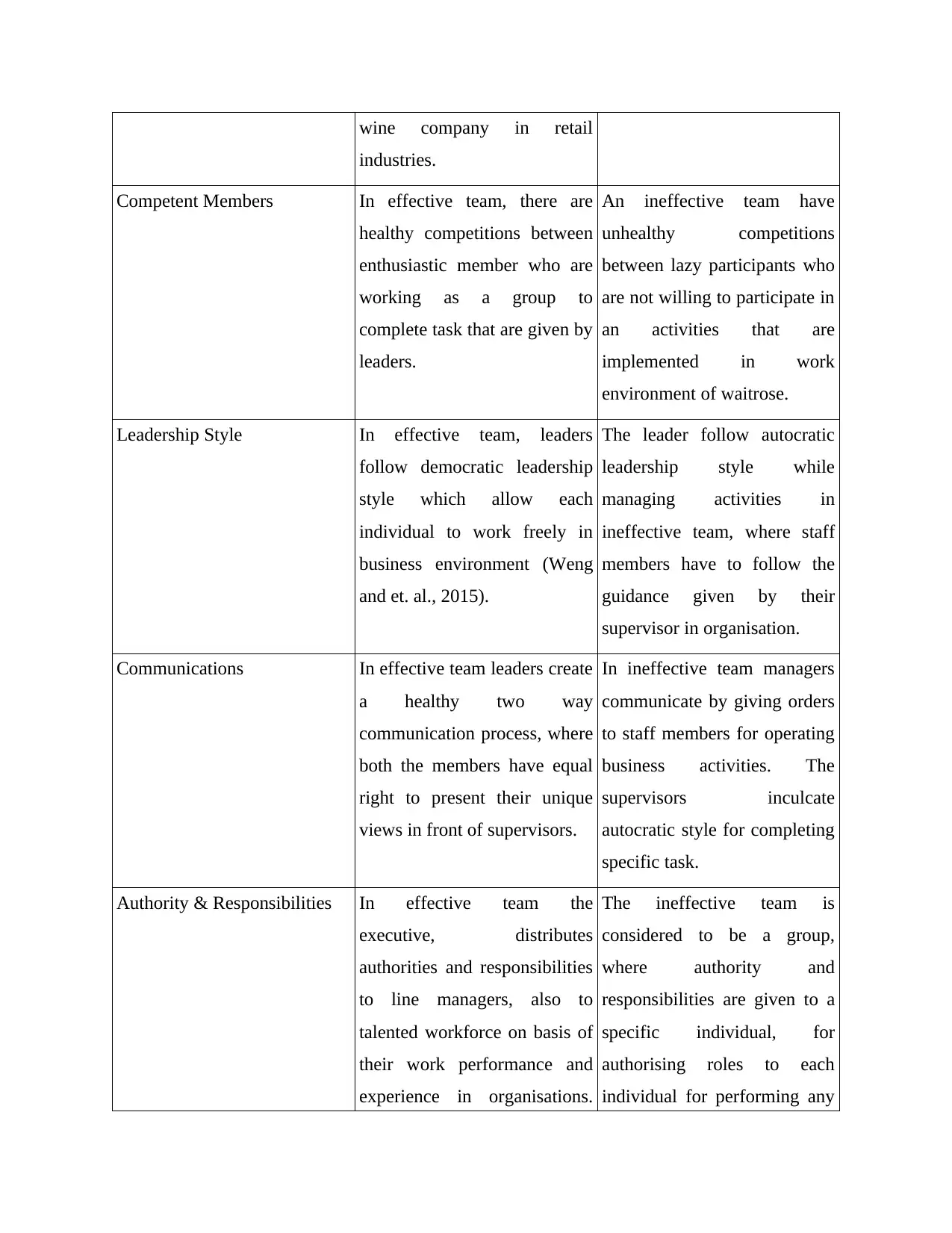
wine company in retail
industries.
Competent Members In effective team, there are
healthy competitions between
enthusiastic member who are
working as a group to
complete task that are given by
leaders.
An ineffective team have
unhealthy competitions
between lazy participants who
are not willing to participate in
an activities that are
implemented in work
environment of waitrose.
Leadership Style In effective team, leaders
follow democratic leadership
style which allow each
individual to work freely in
business environment (Weng
and et. al., 2015).
The leader follow autocratic
leadership style while
managing activities in
ineffective team, where staff
members have to follow the
guidance given by their
supervisor in organisation.
Communications In effective team leaders create
a healthy two way
communication process, where
both the members have equal
right to present their unique
views in front of supervisors.
In ineffective team managers
communicate by giving orders
to staff members for operating
business activities. The
supervisors inculcate
autocratic style for completing
specific task.
Authority & Responsibilities In effective team the
executive, distributes
authorities and responsibilities
to line managers, also to
talented workforce on basis of
their work performance and
experience in organisations.
The ineffective team is
considered to be a group,
where authority and
responsibilities are given to a
specific individual, for
authorising roles to each
individual for performing any
industries.
Competent Members In effective team, there are
healthy competitions between
enthusiastic member who are
working as a group to
complete task that are given by
leaders.
An ineffective team have
unhealthy competitions
between lazy participants who
are not willing to participate in
an activities that are
implemented in work
environment of waitrose.
Leadership Style In effective team, leaders
follow democratic leadership
style which allow each
individual to work freely in
business environment (Weng
and et. al., 2015).
The leader follow autocratic
leadership style while
managing activities in
ineffective team, where staff
members have to follow the
guidance given by their
supervisor in organisation.
Communications In effective team leaders create
a healthy two way
communication process, where
both the members have equal
right to present their unique
views in front of supervisors.
In ineffective team managers
communicate by giving orders
to staff members for operating
business activities. The
supervisors inculcate
autocratic style for completing
specific task.
Authority & Responsibilities In effective team the
executive, distributes
authorities and responsibilities
to line managers, also to
talented workforce on basis of
their work performance and
experience in organisations.
The ineffective team is
considered to be a group,
where authority and
responsibilities are given to a
specific individual, for
authorising roles to each
individual for performing any
Paraphrase This Document
Need a fresh take? Get an instant paraphrase of this document with our AI Paraphraser
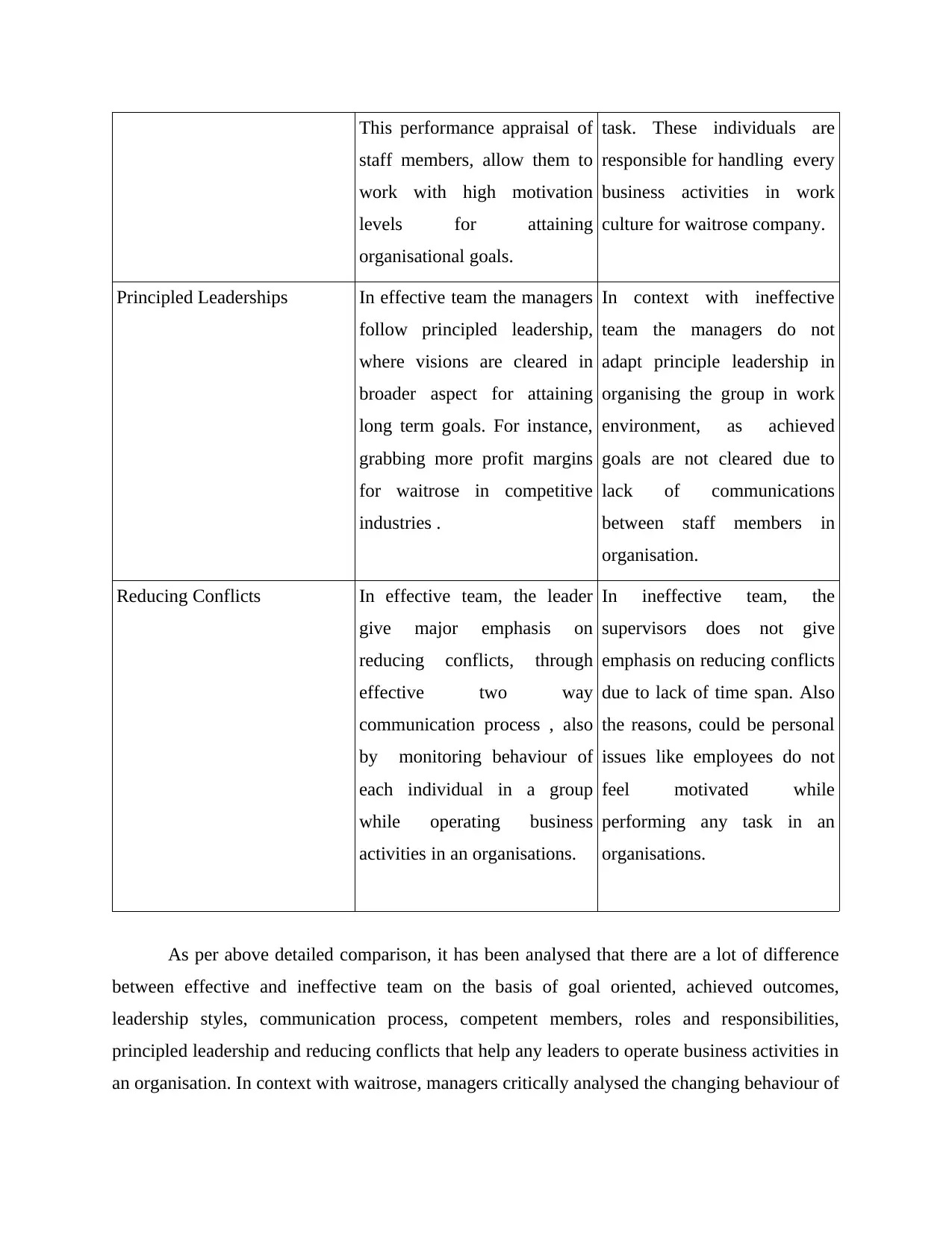
This performance appraisal of
staff members, allow them to
work with high motivation
levels for attaining
organisational goals.
task. These individuals are
responsible for handling every
business activities in work
culture for waitrose company.
Principled Leaderships In effective team the managers
follow principled leadership,
where visions are cleared in
broader aspect for attaining
long term goals. For instance,
grabbing more profit margins
for waitrose in competitive
industries .
In context with ineffective
team the managers do not
adapt principle leadership in
organising the group in work
environment, as achieved
goals are not cleared due to
lack of communications
between staff members in
organisation.
Reducing Conflicts In effective team, the leader
give major emphasis on
reducing conflicts, through
effective two way
communication process , also
by monitoring behaviour of
each individual in a group
while operating business
activities in an organisations.
In ineffective team, the
supervisors does not give
emphasis on reducing conflicts
due to lack of time span. Also
the reasons, could be personal
issues like employees do not
feel motivated while
performing any task in an
organisations.
As per above detailed comparison, it has been analysed that there are a lot of difference
between effective and ineffective team on the basis of goal oriented, achieved outcomes,
leadership styles, communication process, competent members, roles and responsibilities,
principled leadership and reducing conflicts that help any leaders to operate business activities in
an organisation. In context with waitrose, managers critically analysed the changing behaviour of
staff members, allow them to
work with high motivation
levels for attaining
organisational goals.
task. These individuals are
responsible for handling every
business activities in work
culture for waitrose company.
Principled Leaderships In effective team the managers
follow principled leadership,
where visions are cleared in
broader aspect for attaining
long term goals. For instance,
grabbing more profit margins
for waitrose in competitive
industries .
In context with ineffective
team the managers do not
adapt principle leadership in
organising the group in work
environment, as achieved
goals are not cleared due to
lack of communications
between staff members in
organisation.
Reducing Conflicts In effective team, the leader
give major emphasis on
reducing conflicts, through
effective two way
communication process , also
by monitoring behaviour of
each individual in a group
while operating business
activities in an organisations.
In ineffective team, the
supervisors does not give
emphasis on reducing conflicts
due to lack of time span. Also
the reasons, could be personal
issues like employees do not
feel motivated while
performing any task in an
organisations.
As per above detailed comparison, it has been analysed that there are a lot of difference
between effective and ineffective team on the basis of goal oriented, achieved outcomes,
leadership styles, communication process, competent members, roles and responsibilities,
principled leadership and reducing conflicts that help any leaders to operate business activities in
an organisation. In context with waitrose, managers critically analysed the changing behaviour of
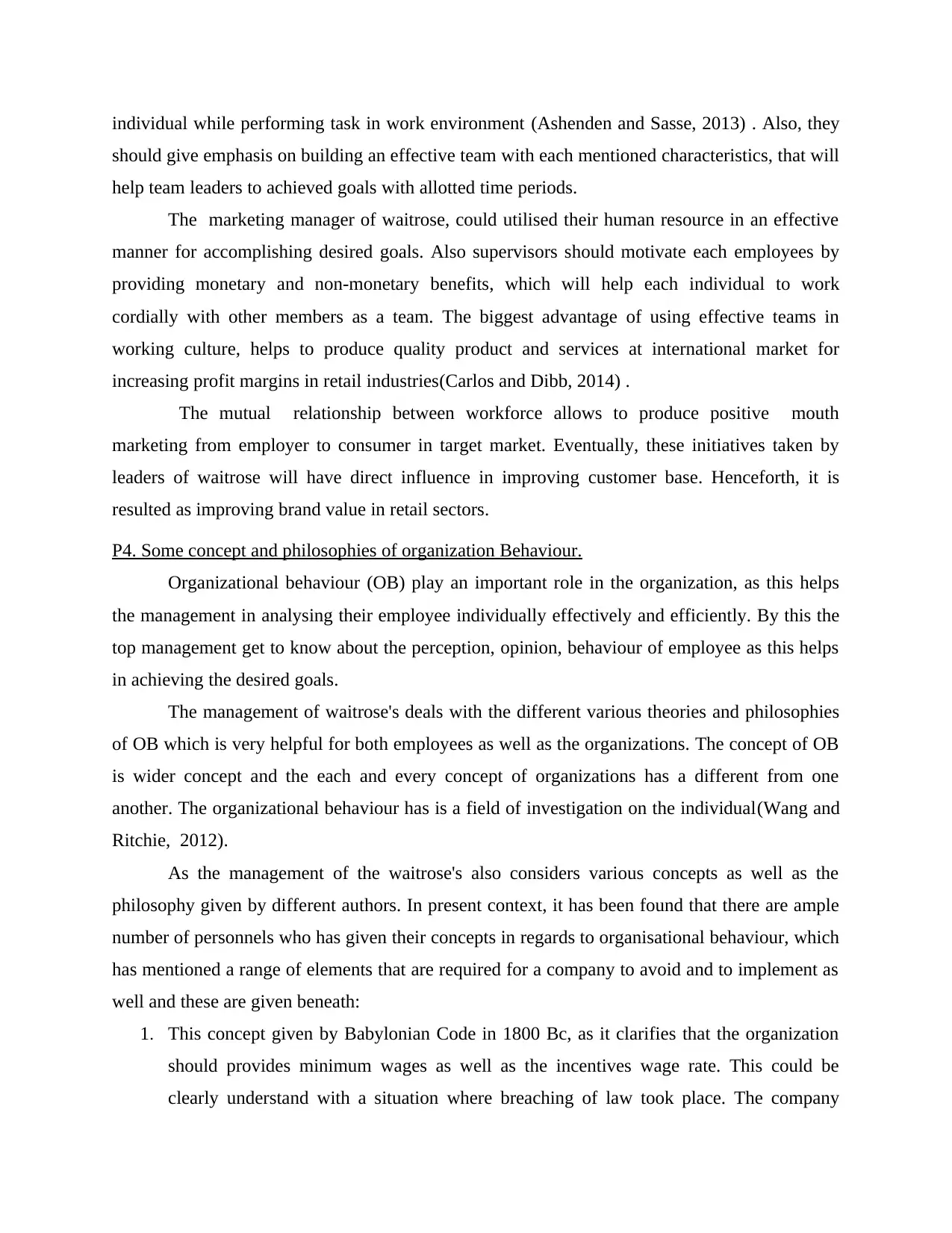
individual while performing task in work environment (Ashenden and Sasse, 2013) . Also, they
should give emphasis on building an effective team with each mentioned characteristics, that will
help team leaders to achieved goals with allotted time periods.
The marketing manager of waitrose, could utilised their human resource in an effective
manner for accomplishing desired goals. Also supervisors should motivate each employees by
providing monetary and non-monetary benefits, which will help each individual to work
cordially with other members as a team. The biggest advantage of using effective teams in
working culture, helps to produce quality product and services at international market for
increasing profit margins in retail industries(Carlos and Dibb, 2014) .
The mutual relationship between workforce allows to produce positive mouth
marketing from employer to consumer in target market. Eventually, these initiatives taken by
leaders of waitrose will have direct influence in improving customer base. Henceforth, it is
resulted as improving brand value in retail sectors.
P4. Some concept and philosophies of organization Behaviour.
Organizational behaviour (OB) play an important role in the organization, as this helps
the management in analysing their employee individually effectively and efficiently. By this the
top management get to know about the perception, opinion, behaviour of employee as this helps
in achieving the desired goals.
The management of waitrose's deals with the different various theories and philosophies
of OB which is very helpful for both employees as well as the organizations. The concept of OB
is wider concept and the each and every concept of organizations has a different from one
another. The organizational behaviour has is a field of investigation on the individual(Wang and
Ritchie, 2012).
As the management of the waitrose's also considers various concepts as well as the
philosophy given by different authors. In present context, it has been found that there are ample
number of personnels who has given their concepts in regards to organisational behaviour, which
has mentioned a range of elements that are required for a company to avoid and to implement as
well and these are given beneath:
1. This concept given by Babylonian Code in 1800 Bc, as it clarifies that the organization
should provides minimum wages as well as the incentives wage rate. This could be
clearly understand with a situation where breaching of law took place. The company
should give emphasis on building an effective team with each mentioned characteristics, that will
help team leaders to achieved goals with allotted time periods.
The marketing manager of waitrose, could utilised their human resource in an effective
manner for accomplishing desired goals. Also supervisors should motivate each employees by
providing monetary and non-monetary benefits, which will help each individual to work
cordially with other members as a team. The biggest advantage of using effective teams in
working culture, helps to produce quality product and services at international market for
increasing profit margins in retail industries(Carlos and Dibb, 2014) .
The mutual relationship between workforce allows to produce positive mouth
marketing from employer to consumer in target market. Eventually, these initiatives taken by
leaders of waitrose will have direct influence in improving customer base. Henceforth, it is
resulted as improving brand value in retail sectors.
P4. Some concept and philosophies of organization Behaviour.
Organizational behaviour (OB) play an important role in the organization, as this helps
the management in analysing their employee individually effectively and efficiently. By this the
top management get to know about the perception, opinion, behaviour of employee as this helps
in achieving the desired goals.
The management of waitrose's deals with the different various theories and philosophies
of OB which is very helpful for both employees as well as the organizations. The concept of OB
is wider concept and the each and every concept of organizations has a different from one
another. The organizational behaviour has is a field of investigation on the individual(Wang and
Ritchie, 2012).
As the management of the waitrose's also considers various concepts as well as the
philosophy given by different authors. In present context, it has been found that there are ample
number of personnels who has given their concepts in regards to organisational behaviour, which
has mentioned a range of elements that are required for a company to avoid and to implement as
well and these are given beneath:
1. This concept given by Babylonian Code in 1800 Bc, as it clarifies that the organization
should provides minimum wages as well as the incentives wage rate. This could be
clearly understand with a situation where breaching of law took place. The company
⊘ This is a preview!⊘
Do you want full access?
Subscribe today to unlock all pages.

Trusted by 1+ million students worldwide
1 out of 18
Related Documents
Your All-in-One AI-Powered Toolkit for Academic Success.
+13062052269
info@desklib.com
Available 24*7 on WhatsApp / Email
![[object Object]](/_next/static/media/star-bottom.7253800d.svg)
Unlock your academic potential
Copyright © 2020–2025 A2Z Services. All Rights Reserved. Developed and managed by ZUCOL.





